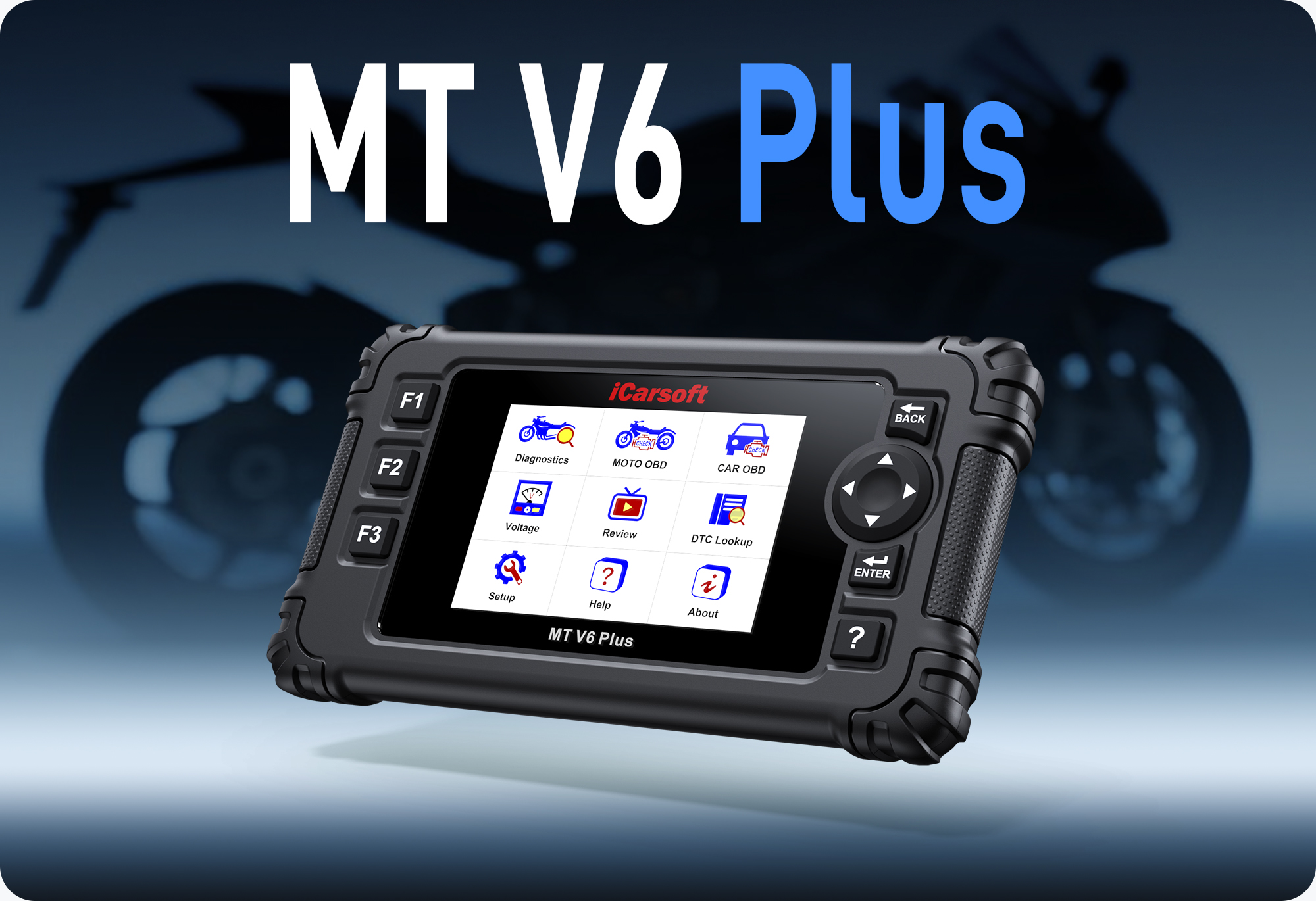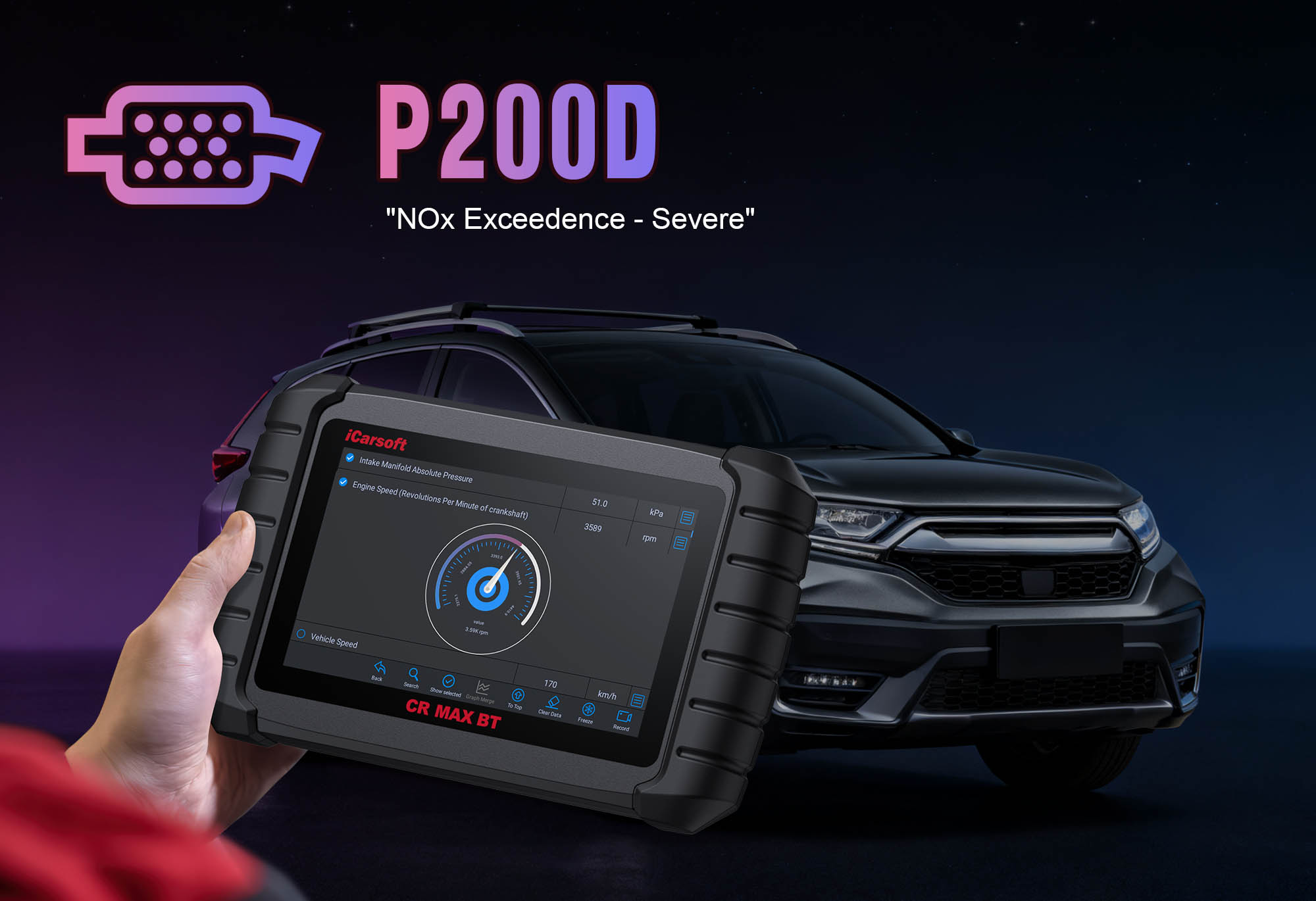Diagnose & Clear P1000 with iCarsoft CR MAX BT: Fix OBDII Monitor Not Ready
If your check engine light (CEL) illuminates or remains on after repairs, and a scan returns P1000, your vehicle’s Engine Control Module (ECM) is signaling that OBDII readiness monitors haven’t completed their self-tests. This manufacturer-specific code (most common in Ford, Lincoln, Mercury, and select Mazda models) stands for "OBDII Monitor Not Ready"—meaning the ECM hasn’t verified that key emissions systems (EVAP, O2 sensor, catalytic converter, etc.) are functioning correctly since the last battery disconnect, code clear, or ECM reset.
Readiness monitors are critical for emissions compliance: they run automated tests on systems that control hydrocarbons, carbon monoxide, and nitrogen oxides. P1000 itself is not a mechanical fault, but it guarantees a failed emissions test and may mask underlying issues if other diagnostic trouble codes (DTCs) are present. Basic scanners only show "Monitor Not Ready," but the iCarsoft CR MAX BT provides targeted guidance to complete tests and clear the code.
 iCarsoft CR MAX BT showing incomplete (Not Ready) and complete (Ready) OBDII monitors, with customized drive cycle guidance for P1000
iCarsoft CR MAX BT showing incomplete (Not Ready) and complete (Ready) OBDII monitors, with customized drive cycle guidance for P1000
Understanding P1000: Causes & Key Symptoms
P1000 triggers when the ECM resets and loses stored monitor data—here’s what to look for:
Key Symptoms of P1000
-
Check Engine Light (CEL): Illuminates or stays on (even with no other codes) to alert you to incomplete monitors.
-
Failed Emissions Tests: All critical monitors (typically 4–6) must be "Ready" to pass—P1000 is an automatic fail.
-
Monitor Status "Not Ready": Scans show 1+ monitors (e.g., "EVAP System: Not Ready," "Catalyst: Not Ready") as incomplete.
-
No Performance Issues: Unlike codes like P0345 or P0720, P1000 doesn’t cause rough idling, reduced MPG, or shifting problems—it’s purely an emissions compliance alert.
-
Post-Repair Persistence: Appears after battery replacement, ECM reset, or clearing other DTCs (the ECM must re-run all monitor tests).
Common Causes of P1000
|
Cause
|
Description
|
|
Battery Disconnect/Die-Off
|
A dead battery or disconnected terminals reset the ECM, erasing all stored monitor data—most common cause of P1000.
|
|
Recent Code Clear
|
Using a scanner to delete DTCs (even unrelated ones) resets monitor statuses—always confirm monitors are ready before clearing codes.
|
|
ECM Reset/Replacement
|
Reprogramming or replacing the ECM forces a full monitor re-test—requires drive cycles to complete.
|
|
Incomplete Drive Cycles
|
The vehicle hasn’t been driven under specific conditions (speed, temperature, load) needed to trigger monitor tests (e.g., EVAP tests require steady highway speeds).
|
|
Interrupted Tests
|
Turning off the engine mid-test (e.g., stopping during an O2 sensor warm-up cycle) leaves monitors incomplete.
|
|
Underlying System Faults (Rare)
|
A faulty component (e.g., bad O2 sensor, EVAP leak) prevents a monitor from completing—P1000 will appear alongside other codes (e.g., P0130, P0442).
|
Why iCarsoft CR MAX BT Excels at Diagnosing P1000
The CR MAX BT solves the biggest P1000 frustrations—guesswork about which monitors are incomplete and how to complete them:
Monitor Status Breakdown
Clearly labels each monitor as "Ready," "Not Ready," or "Failed" (e.g., "EVAP: Not Ready, O2 Sensor: Ready")—no more vague "monitor fault" messages.
Customized Drive Cycle Guides
Provides vehicle-specific steps for incomplete monitors (e.g., "Ford F-150 EVAP: 30 mph for 5 min → 50 mph for 10 min")—tailored to Ford/Mazda requirements.
Real-Time Test Progress
Tracks monitor status as you drive, sending alerts when a monitor switches to "Ready" (e.g., "Catalyst Monitor: Now Ready!").
ECM Reset History
Shows when the ECM last reset (e.g., "Battery Disconnect: 2 days ago") to contextualize why P1000 appeared.
Vehicle-Specific Calibration
Accounts for manufacturer differences (e.g., Ford’s 2-cycle EVAP test vs. Mazda’s 1-cycle test) for accurate guidance.
Emissions Pre-Test Check
Runs a one-click scan to confirm all monitors are "Ready" before visiting a testing station—avoids wasted trips.
Step-by-Step: Diagnose & Resolve P1000 with iCarsoft CR MAX BT
-
1. Connect & Confirm P1000 + Monitor Status
Plug the CR MAX BT into the OBD-II port and pair with your device via the app (30-second Bluetooth setup).
Select your vehicle using Auto VIN Scan (instant VIN read) or manual entry (make/model/year/engine—critical for Ford/Mazda specificity).
- Navigate to Engine > Fault Codes > Read Codes to confirm P1000.
- Go to Engine > Live Data > Readiness Monitors to identify incomplete monitors (e.g., "EVAP: Not Ready, Catalyst: Not Ready").
-
2. Rule Out Underlying Faults
P1000 may mask other issues—use the CR MAX BT to verify:
- Check for Other Codes: Go to Engine > Fault Codes > Read Codes. If P1000 appears with codes like P0442 (EVAP leak) or P0130 (O2 sensor), fix those first—they’re blocking monitor completion.
- Battery Health Test: Navigate to General Diagnostics > Battery Test. Ensure voltage is 12.4–12.7V (off) and 13.5–14.5V (running)—a weak battery interrupts monitor tests.
- ECM Reset History: Go to Engine > ECU Information > Reset History to see if the ECM was reset recently (e.g., battery disconnect).
-
3. Follow Vehicle-Specific Drive Cycles
The CR MAX BT’s customized guides are the key to completing monitors—no more random driving:
- Go to Special Functions > Emissions > Readiness Monitor Drive Cycle.
- Select the incomplete monitor (e.g., "EVAP System")—the app displays step-by-step instructions (example for Ford F-150):
1. Start engine, idle for 2 minutes (warm-up to 180°F+).
2. Accelerate to 30 mph, hold steady for 5 minutes (triggers EVAP pressure test).
3. Accelerate to 50 mph, hold steady for 10 minutes (completes EVAP leak check).
4. Decelerate to 20 mph, hold for 2 minutes, then turn off engine for 1 minute.
- Use the app’s Live Monitor Progress to track when the monitor switches to "Ready" (alerts pop up on your device).
Note: Some monitors (e.g., Catalyst) require 2–3 drive cycles or cold starts—follow the app’s prompts.
-
4. Verify Monitor Completion
After the drive cycle, confirm all monitors are ready:
- Park the vehicle, turn off the engine, and wait 1 minute (lets the ECM save data).
- Reconnect the CR MAX BT and go to Engine > Live Data > Readiness Monitors.
- Ensure all critical monitors (EVAP, O2 Sensor, Catalyst, EGR) are marked "Ready." If one remains incomplete, repeat the drive cycle—some tests require precise conditions (no sudden stops, consistent speed).
-
5. Clear P1000 (If Needed)
P1000 often clears automatically once all monitors are "Ready," but if it persists:
- Navigate to Engine > Fault Codes > Clear Codes.
- Select "Clear P1000" (the app will confirm deletion).
- Re-scan immediately to ensure P1000 doesn’t return. If it does, 1+ monitors are still incomplete—repeat Step 3 for those monitors.
-
6. Run Emissions Pre-Test Check
Avoid failed emissions tests with a final verification:
- Go to Special Functions > Emissions > Pre-Test Check.
- The CR MAX BT scans all monitors and generates a "Pass/Fail" report. If it shows "All Monitors Ready," you’re set for testing. If not, repeat the drive cycle for incomplete monitors.
Preventing P1000 Recurrence
The CR MAX BT helps you avoid P1000 and emissions test failures long-term:
-
Avoid Unnecessary Code Clears: Use the app’s Code Details to only clear relevant codes. Never clear codes before confirming monitors are "Ready" (check via Readiness Monitors).
-
Battery Maintenance Reminders: Set a Service Reminder in the app to check battery health quarterly. Replace weak batteries before they die and reset the ECM.
-
Post-Repair Drive Cycles: After battery replacement, ECM work, or code clears, run the app’s drive cycles immediately—don’t wait until emissions testing.
-
Regular Monitor Checks: Use the Quick Scan monthly to confirm monitors stay "Ready." Catch incomplete tests early (e.g., after a short trip that didn’t trigger EVAP tests).
-
Avoid Interrupting Tests: If the app shows a monitor is "Testing," avoid turning off the engine until it completes (the app alerts you when testing is active).
Conclusion
P1000’s "OBDII Monitor Not Ready" code is a frustrating barrier to emissions compliance, but the iCarsoft CR MAX BT eliminates guesswork. By identifying incomplete monitors, providing Ford/Mazda-specific drive cycles, and tracking real-time progress, it turns a vague alert into a straightforward fix.
Unlike basic scanners that leave you wondering "what next," the CR MAX BT guides you every step of the way—ensuring you pass emissions tests, avoid wasted trips, and keep your vehicle compliant. With this tool, resolving P1000 becomes a quick, stress-free process.
FAQs About P1000 Code
Q: Can I drive my vehicle with P1000?
A: Yes—P1000 is not a safety or performance issue. The only limitation is failed emissions tests. Drive normally, but prioritize completing the app’s drive cycles to clear the code before testing.
Q: How long does it take to complete drive cycles for P1000?
A: 30–60 minutes total, depending on the number of incomplete monitors. Simple monitors (O2 Sensor) take 10–15 minutes; complex ones (EVAP, Catalyst) take 20–30 minutes. The CR MAX BT’s real-time alerts let you stop once monitors are ready.
Q: Why do monitors stay "Not Ready" even after driving?
A: Common reasons: 1) Not following vehicle-specific conditions (e.g., Ford requires steady 50 mph for EVAP tests, not stop-and-go); 2) Weak battery (interrupts tests); 3) Underlying fault (e.g., EVAP leak) you missed. Use the CR MAX BT’s battery test and code scan to rule these out.
Q: Will P1000 clear on its own?
A: Yes—once all monitors are "Ready," the ECM automatically clears P1000 within 1–2 drive cycles. If it persists, use the CR MAX BT’s "Clear Codes" function—this only deletes P1000, not monitor data.
Q: Can P1000 mask other engine issues?
A: Yes—if P1000 appears with other codes (e.g., P0345), the ECM may pause monitor tests to prioritize the active fault. Always use the CR MAX BT’s "Read Codes" function first to fix underlying issues before addressing P1000.

 iCarsoft CR MAX BT showing incomplete (Not Ready) and complete (Ready) OBDII monitors, with customized drive cycle guidance for P1000
iCarsoft CR MAX BT showing incomplete (Not Ready) and complete (Ready) OBDII monitors, with customized drive cycle guidance for P1000



